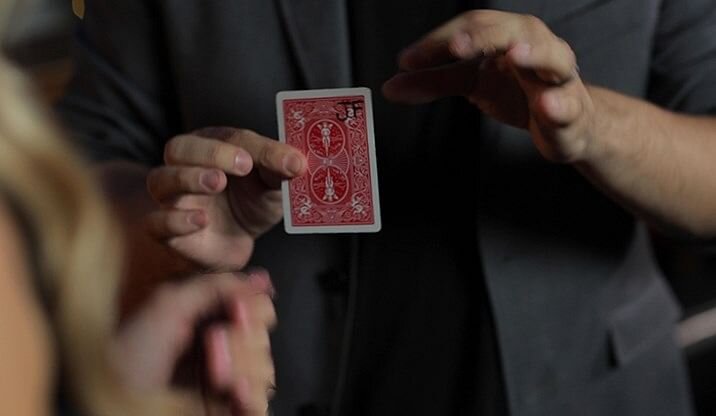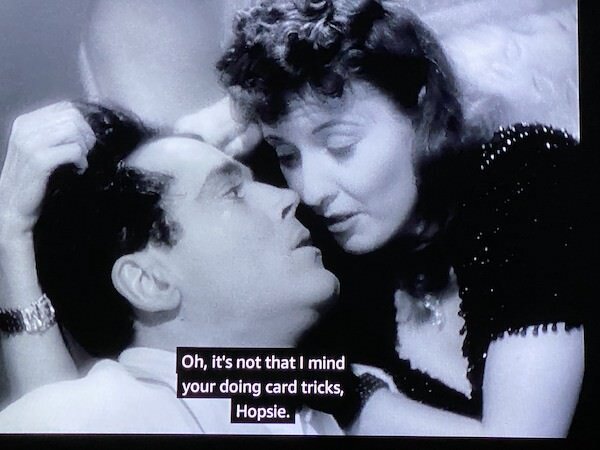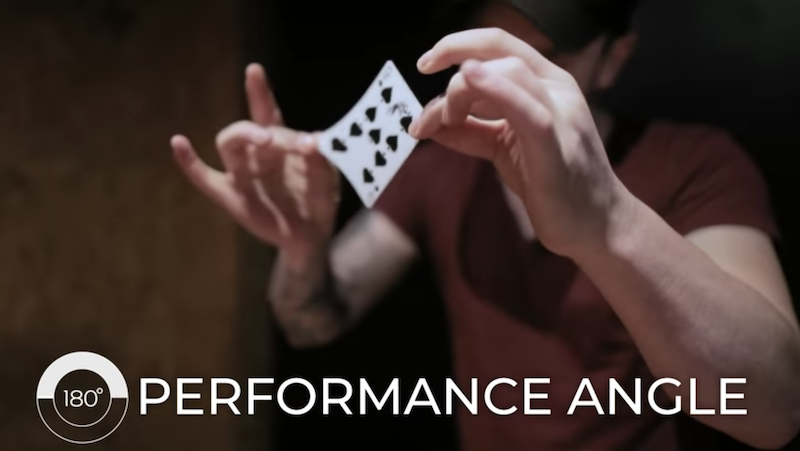Imagine
Stacie, my first houseguest in months comes over to get some dinner and watch a movie. The dinner is Thai food (pretty decent). The movie is The Lovebirds on Netflix (pretty funny—better than I expected).
After dinner I ask for her help with a trick I’ve been working on. Stacie is someone I’ve only known since earlier this year and she’s only seen me perform a couple things in that time.
I give her a deck of cards, have her shuffle it, and then cut it into four piles.
“Okay,” I say, “So there’s a pretty famous trick where the magician is able to cut to the four aces. Now, I thought—how cool would it be—if I could make the someone else cut to the four aces. So that’s a trick I’ve been working on for a few months now.”
(I figure it’s much more exciting for someone to feel like they’re taking part in something new, rather than something that has been honed by a million magicians before me. I don’t feel guilty for taking credit for the spectator cuts the aces plot. I’m doing it for the audience’s benefit. And, in this trick, it’s only a plot point, not the actual plot.)
“Let’s see how you did,” I say and gesture for her to turn over the top cards.
She turns over the 4 of Hearts, 9 of Clubs, Ace of Clubs, and 6 of Diamonds.
“Shit.”
“Well, I got one,” she says sweetly. Seemingly wanting me to feel better.
“Yeah… but I think that was just luck actually. The Ace of Clubs should have been in this pile if it worked like it was supposed to.”
“Four-Nine-Ace-Six,” I say, absentmindedly, like I’m just trying to make sense of what I I’m looking at, or what went wrong.
“Is 4 9 1 6 your lucky number by any chance? That would still be a good trick.”
“It could be,” she says. “Do people have lucky 4-digit numbers?”
“Wait, wait, wait…,” I say, shifting tone to something a bit more serious. “Look at it from this side, 6 Ace 9 4. 6 1 9 4. Isn’t that…?” I look at her expectantly, but she doesn’t say anything. I’m a little less certain now. “Isn’t that… aren’t those the last four digits of your phone number?”
“Ah! Yes!” she says. “I mean, no. But it’s close. It’s 6 1 4 9.”
We sit with it for a moment. Is this sort of interesting? Is it not? Maybe it is. Or maybe if you cut to four cards you’re bound to find a number that means something to someone in some manner some of the time… especially if you allow for the numbers to not be in the exact right order. I think the general feeling was that it was mildly interesting, but not much more than that.
I put on my “thinking face,” furrowing my brow as if there’s something that’s not making sense to me. “I’m having such weird deja vu,” I say. “This feels familiar…,” I trail off.
It dawns on me.
“Wait, wait, wait, wait. Was that…? Oh man. Hold on. Actually… come with me.”
I take Stacie’s hand and pull her into my bedroom.
I pick up a notebook that is sitting on my night-stand.
“So, when the coronavirus started, a lot of people were having really crazy dreams. So I had the idea to keep track of any dreams I remembered when I woke up. It’s not that I think they’re interesting. Not to anyone else, at least. It was just a thing to do.” I say this as I’m flipping through the book.
“I think… I mean, I’m not really sure because I write them down just after I wake up and then they’re pretty much gone, but I think…. Wait… yes… here it is.” As I say this, I walk with her back to the living room and the cards she cut earlier.
I hand her the book and she reads the entry on the page.
Tonight I dreamt that Stacie K came over for dinner and a movie.
The movie was a comedy. I’m not sure what we ate. She was in a
red blouse or shirt. After dinner I showed her the ace cutting trick
I’ve been working on. But she only found the Ace of Clubs. Then
we realized if we flipped the nine of clubs and the four of hearts it
would have been the last four digits of her phone number. We
couldn’t figure out if that meant anything. But something about
it felt familiar to me.
We look down at the cards again.
“What in the fuck…” she whispers.
Method
This is so much fun.
I don’t share too many of my own polished effects/presentations on the site these days. I save those for the annual supporter’s reward book. But I thought I’d share this one (for a little while, this post will disappear at some point in the future) because it was borne out of someone’s submission to a contest I had on the site a couple months ago.
People who’ve read my work for a while will recognize this as just another dressing up for Spectator Cuts the Aces. I’ve written about this trick in the past, and also in general about the value of “blank slate” effects (effects that can easily be recontextualized).
You don’t have to use Spectator Cuts the Aces. You can slide in any sort of trick that ends with a known outcome. Mainly the idea I want to share is about burying a prediction in a dream journal. (I’m going to provide you with a very simple way to do this later in the post.)
I’m very happy with the nature of the prediction as outlined in the performance described above. My first inclination was, perhaps obviously, to have them cut to four cards and then have those exact four cards predicted in my dream journal. But something about that felt just a little too clean. Would I really remember four random cards upon waking up if there was nothing noticeable about them? By having the almost match of the phone-number, I get to actually name (or suggest) the value of all four cards, and the suits of three of them in the dream journal, without it feeling like I was noting the cards specifically so I could reference them later. And the almost match of the phone number feels like something that would be more likely to jog my memory of this forgotten dream than just seeing four random cards.
I also wanted to add some other subtle predictions in the write-up, but not go overboard with it. I could have said, “Stacie came over. She was wearing a red shirt and black shorts. She commented that she liked the color of my Artisan stand mixer. She ordered the pineapple fried rice. [Etc., etc.]” I could have just written that in earlier in the night (as I did write in the color of her top earlier that evening), but I chose not to. I just wanted to hint at the idea that perhaps there was even more in the dream that was accurate, but I just didn’t remember it or write it down when I awoke.
The idea for this presentation came to me after the Better with Weber contest a few months ago. That contest asked people to identify a goal they wanted to achieve for the month of April. Supporter, Lucas Jarche, wrote in to say his goal was to write down his dreams every morning. The next month, when the Better with the Jerx contest asked people to supply the proof of what they achieved in April, Lucas sent along a document describing his dreams from the previous month.
I immediately saw the potential for a strong presentation here. What if we buried a prediction somewhere in the journal?
Think of the difference between these two presentations.
1. “I had a dream last night that I performed a card trick for you. When I woke up, I wrote out that dream and I have it here on this piece of paper.”
2. Card trick happens. The ending reminds you of something. You go and get your dream journal and flip through it. “I swear I had a dream that was sort of like this.” Flip. Flip. Flip. “Huh… maybe I’m misremembering. I really thought… Wait! Here it is.”
The first way is sort of the standard magician’s way of paying lip-service to a potentially interesting premise.
The second version will go much further towards pulling the spectator into the world of the story.
Ideally, to perform this, you’ll actually create a dream journal. Either a real one that you keep for at least a month or so, or just one that you make up altogether over the course of a couple hours. The more entries you have, the better. I think it looks best with at least 60 or so. They don’t have to be long. Use different writing implements throughout the journal (there’s a reason for this). Leave a page blank near the middle.
The trick is personalized, but the prop is reusable. And that’s because I use a frixion pen to write the entry for the “prediction” dream. This is the reason for using different writing implements in the book, so it’s not just this one entry that looks a little different than all the others.
Don’t be lazy, it’s not that much work.
But, if you are a little lazy, I have another option for you.
Lucas Jarche is allowing me to share a file of his dream journal with you. So what you can do is go in and edit one of the entries so it consists of whatever prediction you need.
Then just print it out. It’s okay if the dream journal is done on a computer rather than hand-written (although it’s not as good). But either way it needs to be a physical copy that you show them for the reveal. If you just bring up a document on your computer or phone it will have significantly less impact. It’s not even really worth doing that way.
Here’s that document.
Again though, if you really want to make it as strong as possible, hand-write it in a bound journal. You want them to feel like: Well, he wouldn’t have gone to all the a trouble for just a magic trick, right? From their perspective you would have to remake the whole book to ever show the trick to someone else. (But due to the frixion pen, that’s not the case.)
You might wonder why I would act as if I’m surprised that it matches up with the dream journal, when theoretically, if I had dreamed it already, I should have been on guard against something like this happening when I performed this trick. The logic that I had in my head if I was questioned on that point was this: “I write in that book when I’m barely half-awake. I forget most of the details soon after. And because I do a lot of card tricks in real life, it’s not unusual for me to have dreams about them. They don’t really stand out when they happen.” But that wasn’t a logic leap my friend took, so I didn’t have to justify it in any way.
There it is. Thanks again to Lucas for allowing me to share his dream journal with you.
Also, if you have the charm to pull it off (I wouldn’t bet on it), you could put a description of a graphic sex dream between you and your spectator later in the book. Then, after the trick, you can be flipping through the book and be like, “Huh. Oh here’s another dream I had about you. Kind of interesting one. Especially now that I realize I’m having prophetic dreams.” Hand her the book and you’re off to the races.
















